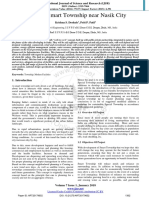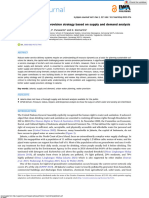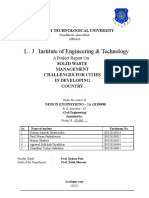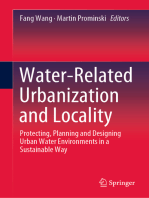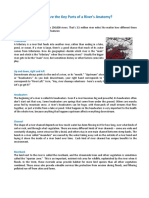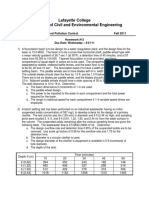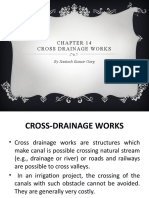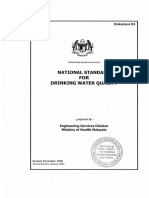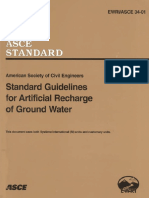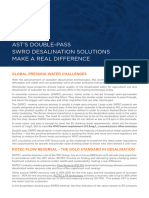Professional Documents
Culture Documents
Need Assessment of Stormwater Management Guidelines in Pokhara and Design of Stormwater Drains For Ward 2 of Pokhara, Nepal
Original Title
Copyright
Available Formats
Share this document
Did you find this document useful?
Is this content inappropriate?
Report this DocumentCopyright:
Available Formats
Need Assessment of Stormwater Management Guidelines in Pokhara and Design of Stormwater Drains For Ward 2 of Pokhara, Nepal
Copyright:
Available Formats
Volume 5, Issue 7, July – 2020 International Journal of Innovative Science and Research Technology
ISSN No:-2456-2165
Need Assessment of Stormwater Management
Guidelines in Pokhara and Design of Stormwater
Drains for Ward 2 of Pokhara, Nepal
Keshav Basnet1, Achyut Bhandari2*, Kaushal Chandra GC3, Nirmal Baral4 and Netra Bahadur Katuwal5
1
MSc Coordinator for Infrastructure Engineering and Management Program, Pashchimanchal Campus, Institute of Engineering,
Tribhuvan University, Nepal;
2
MS student, Infrastructure Engineering and Management Program, Department of Civil and Geomatics Engineering,
Pashchimanchal Campus, Institute of Engineering, Tribhuvan University, Nepal;
1,3,4
Assitant Professor, Department of Civil and Geomatics Engineering, Pashchimanchal Campus, Institute of Engineering,
Tribhuvan University, Nepal
5
MS student, State Key Laboratory of Information Engineering in Surveying,
Mapping and Remote Sensing, Wuhan University, China
Abstract:- Frequent questioning by the publics and Keywords:- Flooding, Overflow, Road side drain, Flood
reports on newspaper about the failure of stormwater management, Stormwater drain.
drainage infrastructure and new opportunity to develop
environmental protection regulations at provincial level I. INTRODUCTION
encouraged to study on the need assessment for
stormwater management guidelines in Pokhara city of A needs assessment is a systematic approach of
Nepal. Analysis for the necessity of such guidelines was studying the state of knowledge, ability, interest, or attitude
performed through different perspectives like quantity of a defined audience or group involving a particular
of runoff, failure of infrastructure services due to subject. The goal of the assessment is to specify what gaps
unmanaged drains, problems faced by the planners due exist, the cost of filling them, and which ones require
to lack to integrated design and so on. In the study, the immediate attention. Stormwater is water from rain and
existing infrastructures were seen to be undersized in melting snow and ice. Stormwater management is the
many areas, water being discharge to natural bodies control and use of stormwater runoff. Stormwater
were below the international practices and their management guidelines provides guidance in the planning
standards and lack of defined polices and regulatory and design of stormwater management infrastructure for
bodies for design, construction and operation escalated developers, consultants, municipalities, and landowners and
these types of social problems in the community. outlines the processes and infrastructure needed to address
Similarly, the basic steps for estimating the storm flooding, water quality, erosion, water balance, and natural
runoff of the selected catchment and determining the heritage.
size of stormwater drains has been discussed that aids to
design of road side drains. Finally, rectangular Pokhara area is selected for the study that lies inside
stormwater drains are designed based on detailed the premises of the Gandaki Province. Political
hydrological study for Ward 2 of Pokhara city in Nepal. categorization of Nepal into urban cities (municipalities and
The need assessment study along with design examples metropolitan cities) and rural areas (Rural Municipalities),
to solve pragmatic challenges plays an important shown in Figure 1, tends to address the pace of urbanization
contribution to government authorities in Pokhara City in different parts of the country. As the impact of
as well as Gandaki Province to formulate guidelines for stormwater is seen higher in the places with huge change in
stormwater management. infiltration rate and capacity and development of other
physical infrastructures, Pokhara metropolis is chose as a
major area for assessment due to its urbanization trend and
high pace of development.
IJISRT20JUL648 www.ijisrt.com 859
Volume 5, Issue 7, July – 2020 International Journal of Innovative Science and Research Technology
ISSN No:-2456-2165
Fig 1:- Municipalities and Rural Municipalities in Gandaki Province, Nepal
(Source: LGCDP, 2019)
After the study of the past design procedures, III. OBSERVATIONS AND FINDINGS
international practices, national design guidelines for
different adjoining infrastructures like roads, canals, etc., a A. Scenario Analysis
basic design steps for the construction of stormwater drain Practice Around the World
is suggested for Pokhara area in a set of solution examples Chang et. al (2018) in their studies on low impact
corresponding to the issues facing by government engineers development analysis for storm water management in urban
in the lack of proper guidelines. Furthermore drain size for cities concluded the western communities paid more
storm water drains based on those example solutions were attention to restore water quality while the eastern
designed in this study and presented for Ward 2 of Pokhara. communities prioritized on flood prevention and rainwater
harvesting. In USA two types of measures are in use for
II. METHODOLOGY stormwater control viz., nonstructural and structural control
measures. The Clean Water Act (1987) and its following
A need assessment is the through study of the supporting regulation and programs made various
requirement of something as per the clients from different provisions to collect the stormwater separately, and
possible viewpoints and its careful analysis. After studying discharge it to the water bodies only after the proper
the various guidelines from different cities from different treatment and removal of the impurities. However, the act
countries of the world, it was concluded that the proper in Australia focus on discharge of the stormwater from the
management guidelines determine the main principle on the cities to the nearby water courses as soon as possible.
stormwater, then describes about the quantity of runoff Chang et. al (2018) also concluded that governments who
discharge, minimum quality of the water before its took proactive and aggressive measures, whether through
disposal, design ideology of the infrastructural components policies, regulations, or incentives, proved to be the most
and its operation strategies. Based on the same findings, successful and are facilitating the shift from gray cities to
this study firstly analyzed about various approaches in green cities. (Committee on Reducing Stormwater
developed cities. Then the overview study of the catchment Discharge Contributions to Water Pollution, 2008;
was conducted followed by the present condition of quality Environment and Communications References Committee,
and quantity of runoff in different parts of Pokhara during 2015).
rainfall period. Similarly, the social need for the guidelines
and its scope was studied and then the brainstorming was Study of Catchment
done considering all the internal and external factors for the In Gandaki Province, there are total 27 municipalities
requirement of the stormwater management guidelines in and 58 rural municipalities covering the total area of 21,733
the area like Pokhara valley of the Gandaki province, sq. km. (14.66% area of country). Political categorization
Nepal. of Nepal into urban cities (municipalities and metropolitan
cities) and rural areas (rural municipalities) tends to address
Similarly, based on the existing studies and the pace of urbanization in different parts of the country.
interdisciplinary national guidelines, a basic approach to The problems related to stormwater management is seen
estimate and design stormwater was studied with the base directly proportional to the pace of urbanization and the
study from the different guidelines of the developed rate of change of land use patterns.
countries.
IJISRT20JUL648 www.ijisrt.com 860
Volume 5, Issue 7, July – 2020 International Journal of Innovative Science and Research Technology
ISSN No:-2456-2165
Fig 2:- Spatial Variation of Mean Annual Precipitation (mm) in Nepal
(Source: Karki et. al, 2015)
Spatial variation of mean annual precipitation across the county is presented in Figure 2. Nepal, in a year, receives about
1,500 mm of rainfall in a good monsoon regime as per the record of Department of Hydrology and Meteorology. Rainfall is
concentrated, and more than 75% of the annual rainfall occurs during the monsoon months beginning June through September.
Weather and meteorological studies along with Department of Hydrology and Meteorology of Nepal has concluded the extreme
events are mostly seen in the Pokhara valley at Lumle station, along with the highest mean annual precipitation in the whole
nation. Being the Pokhara valley, a major city in the Gandaki Province, dealing with the issues of stormwater management and
high pace of urbanization in the region, it is considered as the main study area for the research purpose.
Fig 3:- Grade of Hydraulic Load of the Drainage Conduit in Existing Condition (Source: Basnet et. al, 2020)
IJISRT20JUL648 www.ijisrt.com 861
Volume 5, Issue 7, July – 2020 International Journal of Innovative Science and Research Technology
ISSN No:-2456-2165
Quantity of Stormwater The analysis shows that 80% of the catchment area is
High change in land use pattern can be seen in the covered by impervious surface that includes the surface
Pokhara valley, due to high pace of urbanization. with the area covered by roads, residential and commercial
increase in urbanized area and the city of high mean annual buildings, etc. With increase in the impervious area and the
rainfall, the problems related to the runoff management has frequency of the extreme precipitation events happening in
been seen numerous times in the Pokhara valley. Various the area, this loading factor are supposed to rise further.
studies have been done to suggest the appropriate changes
required to accommodate the runoff in that sub catchment. Social Need for the Guidelines
The existing drainage network was designed and Environment Protection Act, 2053 has been
constructed by the Pokhara Municipality Office in 1998 terminated and with the termination of the act, Environment
with the financial aid from Asian Development Bank. Protection Rules, 2054 has also to be re-formulated to cope
Basnet et. al (2020) studied about the stormwater drainage with the new act. The central act Environment Protection
system for major area of Pokhara and analyzed about the Act, 2076 has been formulated with the clear distinction on
existing infrastructures and its load factor in various decentration of the power to the federal level government.
network inside the city area. Figure 3 shows the loading The upcoming federal rules and regulations for
factor calculated from the modelling of the catchment with environment protection is being drafted on many levels.
their actual sizes of the drains in the given network.
Fig 4:- Overflow on a Road of Lakeside, Pokhara During Heavy Rainfall
(Source: Khadka & Basnet, 2019)
Similarly, the unmanaged and unplanned drainage check the pollutants at the point source. The quantity of the
network can be seen in the different parts in the valley. An of runoff can be determined by the Rational formula;
example of the overflow problem can be seen in Figure 4. 𝑄 = 𝐶𝑖𝐴,
The main reason for such consequences is consider due to
the lack of integrated master plan for the city drainage where, Q is the peak surface runoff rate from a
network and lack of guidelines. Planners and engineers watershed in m3/sec, C is the runoff coefficient at the
have been working on their own knowledge without proper surface of the catchment, A is the area of catchment in
inter communication between different places that have hectares, and i is the intensity of rainfall storm in mm/hr.
caused the social problems like failure of transportation
facilities and sidewalks, over topping of water from the Study of Catchment and Area of Drainage
drainage system on road pavements and hence affecting the Digital elevation model made through the GIS
aesthetic beauty of the cityscape. Sometime the news also software are very effective for determining the flow
has been reported of human casualties and death due to the network of the area. If the model is not available than the
high runoff of stormwater overtopping in the road topographical map with high precision can be used. For an
pavement. urban location, a map that illustrates existing physical
infrastructures is recommended as it helps to identify the
B. Drainage Design existing drainage system as well as locations for major
Major Principle Adopted drains and cross drainages. Firstly, the overall area is
Best to aim to transport the stormwater as rapidly as scanned to layout the major drainage network and the cross
possible from our urban areas to the nearest waterways. drainages such to drain the stormwater to the natural bodies
The best way to control the pollution in the runoff is to as fast as possible.
IJISRT20JUL648 www.ijisrt.com 862
Volume 5, Issue 7, July – 2020 International Journal of Innovative Science and Research Technology
ISSN No:-2456-2165
IJISRT20JUL648 www.ijisrt.com 863
Volume 5, Issue 7, July – 2020 International Journal of Innovative Science and Research Technology
ISSN No:-2456-2165
Coefficient of Runoff
Coefficient of runoff defines the fraction of precipitation that has been converted to the surface runoff. Different land
surfaces with different land cover have different coefficients. The land use map of the aera is to be obtained from the Survey
Department. The mutual coordination between survey department, local government planning commission, and its executive
brings the best updated map of land use land cover (LULC) map of the given locality at the given time. The coefficients from
Table 1 can be used as considering design criteria.
Type of Drainage Area Runoff Coefficient
Business:
Downtown areas 07.0 – 0.95
Neighborhood areas 0.50 – 0.70
Residential:
Single-family areas 0.30 – 0.50
Multi units, detached 0.40 – 0.60
Multi units, attached 0.60 – 0.75
Suburban 0.25 – 0.40
Apartment dwelling areas 0.50 – 0.70
Industrial:
Light areas 0.50 – 0.80
Heavy areas 0.60 – 0.90
Parks, cemeteries 0.10 – 0.25
Playgrounds 0.20 – 0.40
Railroad yard areas 0.20 – 0.40
Unimproved area 0.10 – 0.30
Lawns:
Sandy soil, flat 2% 0.05 – 0.10
Sandy soil, average 2 to 7% 0.10 – 0.15
Sandy soil, steep, 7% 0.15 – 0.20
Heavy soil, flat 2% 0.13 – 0.17
Heavy soil, average, 2 to 7 % 0.18 – 0.25
Heavy soil, steep, 7% 0.25 – 0.35
Streets:
Asphaltic 0.70 – 0.95
Concrete 0.80 – 0.95
Brick 0.70 – 0.85
Drives and walks 0.75 – 0.85
Roofs 0.75 – 0.95
Table 1:- Runoff Coefficients in Urban Areas
Source:(Water Security Agency, 2014)
IJISRT20JUL648 www.ijisrt.com 864
Volume 5, Issue 7, July – 2020 International Journal of Innovative Science and Research Technology
ISSN No:-2456-2165
Intensity of Rainfall
Intensity of rainfall used to estimate the quantity of runoff is the major interpretation of the maximum rainfall the area might
receive for the given design period. It is the probabilistic approach and is predicted through the past records. The time period for
selecting intensity defines the importance of the infrastructure also. The department of roads in its Nepal Road Standards, 2070
has clearly stated that the return period for different types of road has to be adopted as per their recommendation while
constructing the road drains on either side of the roads as shown in Table 2.
Road Class I and II III IV
Return Period
50 33 25
(In Years)
Table 2:- Return Periods for Calculating Design Discharges
Source:(Department of Roads, 2013)
To address the overall catchment of the Nepal, an empirical formula for the design intensity for different meteorological
locations of Nepal was suggested as;
Ihr = 0.38*H24-hr max. /60 (mm/min)
The tabular format of the hourly rainfall design intensity for different return period of storm in major places of Gandaki
province is presented in Table 3.
Return Period (Years)
Index No. Name of Station
300 100 50 33 10
0601 Jomsom 0.79 0.70 0.65 0.61 0.48
0604 Thakmarpha 0.80 0.70 0.63 0.58 0.42
0605 Baglung 0.94 0.89 0.86 0.83 0.75
0606 Tatopani 0.98 0.87 0.81 0.77 0.62
0607 Lete 0.99 0.86 0.77 0.72 0.52
0609 Beni Bazar 1.29 1.14 1.03 0.95 0.71
0701 Ridi Bazar 2.13 1.84 1.67 1.58 1.22
0702 Tansen 2.98 2.44 2.12 1.90 1.17
0722 Musikot 2.53 2.19 1.98 1.84 1.34
0801 Jagat (Setibas) 1.25 1.06 0.96 0.90 0.68
IJISRT20JUL648 www.ijisrt.com 865
Volume 5, Issue 7, July – 2020 International Journal of Innovative Science and Research Technology
ISSN No:-2456-2165
0802 Khudi Bazar 2.47 2.22 2.04 1.19 1.55
0804 Pokhara Airport 2.64 2.31 2.12 1.93 1.49
0807 Kuncha 2.85 2.41 2.12 1.90 1.30
0808 Bandipur 3.01 2.50 2.17 1.94 1.34
0809 Gorkha 2.91 2.31 1.94 1.66 1.01
0810 Chapkot 2.98 2.53 2.31 2.14 1.58
0811 Malepatan Pokhara 2.29 2.09 1.96 1.87 1.58
0814 Lumle 2.28 2.06 1.96 1.85 1.58
Table 3:- Estimated Values of Hourly Rainfall Design Intensity in mm/min
Source: (Jha, 2006)
IJISRT20JUL648 www.ijisrt.com 866
Volume 5, Issue 7, July – 2020 International Journal of Innovative Science and Research Technology
ISSN No:-2456-2165
Sizing of the Drain R = hydraulic radius (m), (area/wetted perimeter of the
Manning's formula is perhaps the most widely used channel)
empirical equation for estimating discharge since it relies S = bed slope of the drain
solely on channel characteristics that are easily measured. n = Manning’s roughness coefficient of the drain materials.
Manning's formula is:
1 2 1 Roughness coefficient depends upon the drain
𝑄 = 𝐴𝑅 3 𝑆 2 material used in lining. Recommend values of roughness
𝑛
coefficient for some major drain materials are resented in
where, Table 4.
Q = discharge (m3/s) through a drain
A = cross sectional area of the drain (m²)
Lining Type Roughness (n)
Dry stone 0.025
Dry brick (without mortar) 0.020
Dressed masonry 0.018
Brick 0.017
Random rubble 0.020
Unreinforced concrete 0.015
Shotcrete 0.017
Table 4:- Recommended Values of Roughness Coefficient
Source:(PDSP Manual Volume M 8, 1990)
IJISRT20JUL648 www.ijisrt.com 867
Volume 5, Issue 7, July – 2020 International Journal of Innovative Science and Research Technology
ISSN No:-2456-2165
IV. RESULTS AND DISCUSSION Pokhara Sub-Metropolitan, the area has about 65% of the
total covered by manmade surface. The infrastructures built
The topography of the Gandaki province is vast as it in the past has now either completely damaged or in the
covers plains of terai in south to mountains in north. The verse of collapse. The high runoff in the area has now
average precipitation of the area is also more compared to started to arises the social problems like urban flooding in
any other places of the nation. As the stormwater problems the settlement, obstruction of road network and adverse
are seen on change in land use and infiltration capacity of result in the aesthetic environment after the flooding
the given place, adverse impacts are more seen on the declines. To address the problems, design of storm drain
urbanizing cities. In the study of Pokhara for the need infrastructures is required.
assessment, the quantity of runoff in drains, and major
problems created by the infrastructure failure were Firstly, the major drainage network is studied that
discussed. exists on the city area (Figure 5) and the possible outfalls
are selected.
In the major drainage network of the city, the water
was from residential units and the quantity of runoff was
low before any storm occurred. Then the existing drains
could easily haul the given amount of water to the outfall
locations. While the storm occurred, the quantity of runoff
in the drains were high. Existing drains were heavily
flooded by the rainwater. In the meantime, the drainage
network failed. The runoff spilled over the roads and public
places obstructed the traffic flow, pedestrians’ path,
aesthetic of the city.
Lack of any design procedures to estimate the quantity
and determine the size of the drains has been prolonging
the problems related to effective design in the developing
cities. To address the problem, rational method can be used
to determine the quantity of runoff and manning’s’ for
calculating the required size of the drain. The variables that
affect the designs as intensity of rainfall, land use of the
catchment can be found from different organizations like
meteorological department and survey department
respectively. For calculating the size of drain, the
manning’s coefficient for the selected material can be used
from standard norms.
Drainage Design
A drainage network is to be designed on Ward 2 of Fig 3:- Major Drainage Network of the City (Pokhara
Pokhara Metropolis. Situated on the northern side of former Metropolis)
IJISRT20JUL648 www.ijisrt.com 868
Volume 5, Issue 7, July – 2020 International Journal of Innovative Science and Research Technology
ISSN No:-2456-2165
The design area falls on the northern part of the city. After the land use map of the selected area is created
After knowing the potential outfall location of the drains, and analyzed in Figure 8, it gives the runoff coefficient of
the road networks and the existing drain where noted inside the respective sub catchments. The drains linked with the
the design area as illustrated in Figure 6. Based on the recce road helps to determine the return period for the intensity of
and the topographical map of the design region, the sub- rainfall. After knowing the coefficient of runoff, intensity
catchments were delineated as shown in Figure 7. of rainfall and the area of sub catchments, the runoff of the
respective sub catchments were calculated.
Fig 4:- Road Network of Design Area
Fig 6:- Land Use Land Cover (LULC) Map of Design Area
In the study the whole catchment was divided into
seven different regions. The area covered by each category
based on landcover of the given catchment is shown in
Table 5.
Fig 5:- Sub-Catchment Delineation of Design Area
IJISRT20JUL648 www.ijisrt.com 869
Volume 5, Issue 7, July – 2020 International Journal of Innovative Science and Research Technology
ISSN No:-2456-2165
Land Use / Area
S.N. % Covered
Land Cover (Sq. Mtrs.)
1 Asphalt Road 57561.54 8.35
2 Concrete Road 23438.58 3.40
3 Built-Up Zone 345447.21 50.14
4 Barren Land 248890.9 36.12
5 Park 6196 0.9
6 Agriculture Land 881.19 0.13
7 Bus park 6581.93 0.96
Total 688997.6 100
Table 5:- Land Cover Details of Ward 2, Pokhara Metropolis
Based on the quantity of the runoff, the dimension for the drains to be constructed were calculated for the material used in
construction as cement concrete. The plum concrete or RCC concrete drains can be construed in the regions as per their suitability.
In the design process only the drains are designed, however all the streets need to have the catch drain in the road side to collect
the rainwater from road and then contribute it to the nearest drainage network. In Figure 9, the labels on the drains describe the
design drain width, height and the longitudinal slope of the given section for the drain in the drainage network.
Fig 7:- Design Size of Stormwater Drains for Ward 2, Pokhara Metropolis
IJISRT20JUL648 www.ijisrt.com 870
Volume 5, Issue 7, July – 2020 International Journal of Innovative Science and Research Technology
ISSN No:-2456-2165
V. CONCLUSION [3]. Basnet, K., Chhetri, K. B., & Parajuli, G. (2020).
Hydrological and hydraulic analyses of urban storm
In the assessment, the problems like unmanaged and water drainage system of major area of Pokhara,
inconceivable sizes of the drains, discharge of the grey Nepal. Preprint.
water in the storm drain and lack of any regulatory and [4]. Chang, N. Bin, Lu, J. W., Chui, T. F. M., &
planning bodies were due to the lack of proper rules and Hartshorn, N. (2018). Global policy analysis of low
guidelines. These problems are solved by proper designing impact development for stormwater management in
of the storm drains. As no any procedures are formulated urban regions. Land Use Policy, 70(January), 368–
till the date, the design process of the storm drain network 383. https://doi.org/10.1016/j.landusepol.2017.11.024
is difficult. In the study, the need for guidelines was [5]. Committee on Reducing Stormwater Discharge
performed for the whole city, Pokhara. The heavy hydraulic Contributions to Water Pollution. (2008). Urban
loading in existing drains and poor condition of the drains Stormwater Management in the United States. The
infrastructures shows the importance and necessity of the National Academies Press.
guiding rules. In the design of the storm drain network, https://doi.org/10.17226/12465
Ward 2 was chosen for its heavy urbanization trend. The [6]. Department of Roads. (2013). Nepal Road Standard
area was survey then after determining the area of drainage, 2070.
intensity of rainfall and runoff coefficient of the area were [7]. Environment and Communications References
calculated, the quantity of runoff was calculated. Based on Committee. (2015). Stormwater Management in
the discharge on the sub-catchments the rectangular drains Australia. Retrieved from www.aph.gov.au/senate_ec
were designed for concrete surface with justified freeboard. [8]. Jha, P. C. (2006). Estimation of Hourly Rainfall
Finally, the drain size required in the area was presented in Design Intensity From 24 -hour Maximum Rainfall :
the map form with the required width, height and The Context of Nepal, (March).
longitudinal slope of the drain. In conclusion, this study [9]. Karki, R., Talchabhadel, R., Aalto, J., & Baidya, S. K.
stressed on the need of stormwater management guidelines (2015). New Climatic Classification of Nepal.
for urban areas of Nepal like Pokhara while the Theoretical and Applied Climatology, (July).
methodology adopted here for designing stormwater drains https://doi.org/10.1007/s00704-015-1549-0
and presented as design examples can be used by Pokhara [10]. Khadka, S. & Basnet, K. (2019). Storm Water
City office and Gandaki Province office to start formulating Management of Barahi Chowk Area, Lakeside ,
the storm water management guidelines which is in Pokhara , Nepal using SWMM. KEC Conference,
extreme need for saving not only the roads but also the 2(1), 320–325.
human life. [11]. LGCDP. (2019). Provincial Support Unit (PSU),
Pokhara : Local Governance and Community
The method used to estimate the storm runoff is Development Programme (LGCDP) - II. Retrieved
probabilistic in nature. To calculate the discharge with from http://lgcdp.gov.np/pokhara
more accuracy, major two recommendations are; 1) the [12]. Neupane M., Basnet K., & Parajuli, G. (2020).
land cover of the area in a developing cites changes rapidly, Modeling of urban storm water drainage using
to calculate the land cover and hence the coefficient of HYKAS for Lamachaur, Pokhara, Nepal. Proceedings
runoff, the trend analysis on land use land cover map need of IOE Graduate Conference, Summer 2020.
to be performed frequently, and 2) one need to consider the [13]. PDSP Manual Volume M 8. (1990). Design Manuals
fact that the intensity of the rainfall differs spatially. for Irrigation Projects in Nepal.
[14]. Water Security Agency. Stormwater Guidelines
ACKNOWLEDGEMENT (2014). Saskatchewan, Canada.
Authors would like to thank the Pokhara Municipal
Planning Commission and its members for the immense
support in recce, survey and design process of drainage
network in Ward 2, Pokhara Metropolis.
REFERENCES
[1]. Basnet, K. & Neupane M. (2018). Storm water
drainage design based on hydrological analysis: a case
study on Lamachaur catchment area, Pokhara, Nepal.
Oodbodhan: A Journal of TUTA, Pashchimanchal
Campus.
[2]. Basnet, K., Baniya, U., and Karki, S. (2018).
Comparative study of design discharge calculation
approaches: a case study on Padhu Khola, Kaski,
Nepal. Oodbodhan: A Journal of TUTA,
Pashchimanchal Campus, 5 (5).
IJISRT20JUL648 www.ijisrt.com 871
You might also like
- SEM028 FullPaper ACASESTUDYONWATERLOGGINGPROBLEMSINANURBANAREADocument7 pagesSEM028 FullPaper ACASESTUDYONWATERLOGGINGPROBLEMSINANURBANAREAuyjghuikj yuuuNo ratings yet
- Id 10522Document13 pagesId 10522furkanasilkefeli0No ratings yet
- Urban Flash FloodDocument10 pagesUrban Flash FloodprabhuNo ratings yet
- Towards Government Mechanisms of Sponge City ConstDocument17 pagesTowards Government Mechanisms of Sponge City ConstBludnikovNo ratings yet
- Water Distribution System Modelling of GIS-remote Sensing and EPANET For The Integrated Efficient DesignDocument22 pagesWater Distribution System Modelling of GIS-remote Sensing and EPANET For The Integrated Efficient DesignsughoshpNo ratings yet
- Synposis - Detailed - Revised AllDocument13 pagesSynposis - Detailed - Revised AllMâħêšħ BabuNo ratings yet
- Case Study VishakhapatnamDocument28 pagesCase Study VishakhapatnamAchyuth NaiduNo ratings yet
- Drinking Water Facility in Kalyani Municipality and Its Sustainable Management: A Study in Urban GeographyDocument8 pagesDrinking Water Facility in Kalyani Municipality and Its Sustainable Management: A Study in Urban GeographyEditor IJTSRDNo ratings yet
- Sponge CityDocument12 pagesSponge Cityrijanadhikari451No ratings yet
- Climate resilient Panaji infrastructureDocument28 pagesClimate resilient Panaji infrastructureKris Kiran100% (1)
- Odisha - Final Page 35 PDFDocument113 pagesOdisha - Final Page 35 PDFNibedita DasNo ratings yet
- Case Study PanajiDocument28 pagesCase Study PanajiIsmail IchuNo ratings yet
- Hydraulic Analysis and Improvement of Water Distribution Networks of Dutse Metropolis, NigeriaDocument9 pagesHydraulic Analysis and Improvement of Water Distribution Networks of Dutse Metropolis, NigeriaAZOJETE UNIMAID100% (1)
- Remote Sensing and GIS for Efficient Urban PlanningDocument24 pagesRemote Sensing and GIS for Efficient Urban PlanningUlil AzmiNo ratings yet
- Scoping Study Report HyderabadDocument28 pagesScoping Study Report Hyderabadbharath sandeepNo ratings yet
- Sustainability 14 08288 v2Document28 pagesSustainability 14 08288 v2GianellaNo ratings yet
- Municipal Solid Waste Management in Kolkata Metropolitan Area-A Case StudyDocument11 pagesMunicipal Solid Waste Management in Kolkata Metropolitan Area-A Case StudyAbhi PrasadNo ratings yet
- Analysis of Watersheds in Gandaki Province, Nepal Using QGISDocument13 pagesAnalysis of Watersheds in Gandaki Province, Nepal Using QGISabishrantNo ratings yet
- Critical Review On Smart Systems Adopted in Stormwater Drainage DesignDocument3 pagesCritical Review On Smart Systems Adopted in Stormwater Drainage DesignGRD JournalsNo ratings yet
- THOYA Final SEMINAR Report11Document18 pagesTHOYA Final SEMINAR Report11G-one JustinNo ratings yet
- A Case Study of The Melamchi Water Supply Project in Nepal PDFDocument31 pagesA Case Study of The Melamchi Water Supply Project in Nepal PDFAshish Mani LamichhaneNo ratings yet
- Case Analysis Guidelines and FormatDocument6 pagesCase Analysis Guidelines and FormatJake BaltazarNo ratings yet
- Invest 5Document14 pagesInvest 5Stuwart L BaldoniNo ratings yet
- A Spatial Multi-Objective Optimization Model For Sustainable Urban Wastewater System Layout PlanningDocument8 pagesA Spatial Multi-Objective Optimization Model For Sustainable Urban Wastewater System Layout PlanningMariangelVelascoNo ratings yet
- Water Resources Development Dam EngineeringDocument14 pagesWater Resources Development Dam Engineeringwajid malikNo ratings yet
- Engineering Procedures For ABC Waters Design Features PDFDocument382 pagesEngineering Procedures For ABC Waters Design Features PDFVitor NinaNo ratings yet
- Palaka 2021 IOP Conf. Ser.3A Mater. Sci. Eng. 1197 012014Document10 pagesPalaka 2021 IOP Conf. Ser.3A Mater. Sci. Eng. 1197 012014Marco Jay BalanayNo ratings yet
- "Sponge City" in China-A Breakthrough of Planning and Flood RiskDocument7 pages"Sponge City" in China-A Breakthrough of Planning and Flood RisksjasorinoNo ratings yet
- Fungi Mikoriza ArbuskulaDocument225 pagesFungi Mikoriza ArbuskulaAIDIL GAMING StretNo ratings yet
- Design A Smart Township Near Nasik City: Krishna S. Deokule, Priti P. PatilDocument5 pagesDesign A Smart Township Near Nasik City: Krishna S. Deokule, Priti P. PatilSINDHU GANESANNo ratings yet
- 13897-Article Text-40952-3-10-20200830Document19 pages13897-Article Text-40952-3-10-20200830Irto SimbiakNo ratings yet
- Rural Water Supply Sustainability in NigeriaDocument40 pagesRural Water Supply Sustainability in NigeriaDada Ko Pyaro BadshahNo ratings yet
- # 1.urban Water Management in Cities Historical, Current and Future RegimesDocument9 pages# 1.urban Water Management in Cities Historical, Current and Future RegimesMINALACHEW TAYENo ratings yet
- Assessment of Stormwater Drainage System For Small Urban Watershed: A Case of Shambu Town, Oromia Region, EthiopiaDocument7 pagesAssessment of Stormwater Drainage System For Small Urban Watershed: A Case of Shambu Town, Oromia Region, Ethiopiahabtamu tamiruNo ratings yet
- WMP Tor Okay FinalDocument12 pagesWMP Tor Okay FinalHari PyakurelNo ratings yet
- GRDCF001003Document8 pagesGRDCF001003AASTHA KHURANA SVNITNo ratings yet
- Hydrologic Modelling by NIHDocument240 pagesHydrologic Modelling by NIHda0297956No ratings yet
- Shibani SynopsisDocument12 pagesShibani Synopsishimansu.routNo ratings yet
- Mohammad Zakaria - Water Supply Design Engineer - MSC - 20 Yr ExpDocument4 pagesMohammad Zakaria - Water Supply Design Engineer - MSC - 20 Yr ExpMd. Juwel MondolNo ratings yet
- Preparation of Model Urban Action Plan For Effective Environmental Management: A Case Study From A.PDocument9 pagesPreparation of Model Urban Action Plan For Effective Environmental Management: A Case Study From A.PIAEME PublicationNo ratings yet
- Value Engineering Application For Conceptual Design of Seawater Desalination Plant in JakartaDocument8 pagesValue Engineering Application For Conceptual Design of Seawater Desalination Plant in Jakartaandang ikhsanNo ratings yet
- CENGR-4120: Flood Control and Drainage DesignDocument4 pagesCENGR-4120: Flood Control and Drainage DesignLORNA BACLIGNo ratings yet
- H2OPEN-D-21-00106 - Water Governance - Water Quality - KozhikodeDocument17 pagesH2OPEN-D-21-00106 - Water Governance - Water Quality - KozhikodeDr P S Hari KumarNo ratings yet
- Morphology History JakartaDocument22 pagesMorphology History Jakartazeebee guaNo ratings yet
- Construction and Application Analysis of SWMM Model in Beijing Future Science ParkDocument8 pagesConstruction and Application Analysis of SWMM Model in Beijing Future Science Park12345chairevitaNo ratings yet
- Sustainability 14 13061Document24 pagesSustainability 14 13061ADZRIN JUSALINo ratings yet
- 13-3 GCUS NewsletterDocument4 pages13-3 GCUS Newslettergalaxy2810No ratings yet
- Sustainable Infrastructure in Shrinking CitiesDocument35 pagesSustainable Infrastructure in Shrinking CitiesKent State University Cleveland Urban Design Collaborative100% (2)
- Community-Based Sanitation AsDocument7 pagesCommunity-Based Sanitation AsMuhammad VitraNo ratings yet
- Jakarta Water Supply Provision Strategy Based On Supply and Demand AnalysisDocument13 pagesJakarta Water Supply Provision Strategy Based On Supply and Demand AnalysisAngel YakNo ratings yet
- Rihendyh 2020 IOP Conf. Ser. - Earth Environ. Sci. 506 012037Document11 pagesRihendyh 2020 IOP Conf. Ser. - Earth Environ. Sci. 506 012037Putri Dyah AyuNo ratings yet
- Final Report PDFDocument16 pagesFinal Report PDFAbhi AgrawalNo ratings yet
- Science of The Total Environment: Sabina Kordana, Daniel S ŁyśDocument17 pagesScience of The Total Environment: Sabina Kordana, Daniel S ŁyśamirNo ratings yet
- Urbanizacion Pluvial PDFDocument12 pagesUrbanizacion Pluvial PDFCarol Tabita Chirote CubaNo ratings yet
- Policies Regarding Water Conservation in India (Conserve Water, Conserve Life, Save Water, and It Will Save You)Document11 pagesPolicies Regarding Water Conservation in India (Conserve Water, Conserve Life, Save Water, and It Will Save You)International Journal of Innovative Science and Research TechnologyNo ratings yet
- Renouf, M.A.2Document55 pagesRenouf, M.A.2Jan BakosNo ratings yet
- 2 56 1628770119 9ijeefusdec20219Document8 pages2 56 1628770119 9ijeefusdec20219TJPRC PublicationsNo ratings yet
- Analysis - of - Existing - Stormwater - Drainage - System - For - Central - Zone - of - Hyderabad - City - Using - Stormcad 2Document7 pagesAnalysis - of - Existing - Stormwater - Drainage - System - For - Central - Zone - of - Hyderabad - City - Using - Stormcad 2AbedlwaneesAbelazeezAshoorNo ratings yet
- Renewable Energy Policies for CitiesFrom EverandRenewable Energy Policies for CitiesNo ratings yet
- Water-Related Urbanization and Locality: Protecting, Planning and Designing Urban Water Environments in a Sustainable WayFrom EverandWater-Related Urbanization and Locality: Protecting, Planning and Designing Urban Water Environments in a Sustainable WayNo ratings yet
- Adoption of International Public Sector Accounting Standards and Quality of Financial Reporting in National Government Agricultural Sector Entities, KenyaDocument12 pagesAdoption of International Public Sector Accounting Standards and Quality of Financial Reporting in National Government Agricultural Sector Entities, KenyaInternational Journal of Innovative Science and Research TechnologyNo ratings yet
- Analysis of Financial Ratios that Relate to Market Value of Listed Companies that have Announced the Results of their Sustainable Stock Assessment, SET ESG Ratings 2023Document10 pagesAnalysis of Financial Ratios that Relate to Market Value of Listed Companies that have Announced the Results of their Sustainable Stock Assessment, SET ESG Ratings 2023International Journal of Innovative Science and Research TechnologyNo ratings yet
- A Curious Case of QuadriplegiaDocument4 pagesA Curious Case of QuadriplegiaInternational Journal of Innovative Science and Research TechnologyNo ratings yet
- Forensic Evidence Management Using Blockchain TechnologyDocument6 pagesForensic Evidence Management Using Blockchain TechnologyInternational Journal of Innovative Science and Research TechnologyNo ratings yet
- Improvement Functional Capacity In Adult After Percutaneous ASD ClosureDocument7 pagesImprovement Functional Capacity In Adult After Percutaneous ASD ClosureInternational Journal of Innovative Science and Research TechnologyNo ratings yet
- Fruit of the Pomegranate (Punica granatum) Plant: Nutrients, Phytochemical Composition and Antioxidant Activity of Fresh and Dried FruitsDocument6 pagesFruit of the Pomegranate (Punica granatum) Plant: Nutrients, Phytochemical Composition and Antioxidant Activity of Fresh and Dried FruitsInternational Journal of Innovative Science and Research TechnologyNo ratings yet
- Pdf to Voice by Using Deep LearningDocument5 pagesPdf to Voice by Using Deep LearningInternational Journal of Innovative Science and Research TechnologyNo ratings yet
- Machine Learning and Big Data Analytics for Precision Cardiac RiskStratification and Heart DiseasesDocument6 pagesMachine Learning and Big Data Analytics for Precision Cardiac RiskStratification and Heart DiseasesInternational Journal of Innovative Science and Research TechnologyNo ratings yet
- Late Presentation of Pulmonary Hypertension Crisis Concurrent with Atrial Arrhythmia after Atrial Septal Defect Device ClosureDocument12 pagesLate Presentation of Pulmonary Hypertension Crisis Concurrent with Atrial Arrhythmia after Atrial Septal Defect Device ClosureInternational Journal of Innovative Science and Research TechnologyNo ratings yet
- Severe Residual Pulmonary Stenosis after Surgical Repair of Tetralogy of Fallot: What’s Our Next Strategy?Document11 pagesSevere Residual Pulmonary Stenosis after Surgical Repair of Tetralogy of Fallot: What’s Our Next Strategy?International Journal of Innovative Science and Research TechnologyNo ratings yet
- Food habits and food inflation in the US and India; An experience in Covid-19 pandemicDocument3 pagesFood habits and food inflation in the US and India; An experience in Covid-19 pandemicInternational Journal of Innovative Science and Research TechnologyNo ratings yet
- The Students’ Assessment of Family Influences on their Academic MotivationDocument8 pagesThe Students’ Assessment of Family Influences on their Academic MotivationInternational Journal of Innovative Science and Research Technology100% (1)
- Scrolls, Likes, and Filters: The New Age Factor Causing Body Image IssuesDocument6 pagesScrolls, Likes, and Filters: The New Age Factor Causing Body Image IssuesInternational Journal of Innovative Science and Research TechnologyNo ratings yet
- Optimization of Process Parameters for Turning Operation on D3 Die SteelDocument4 pagesOptimization of Process Parameters for Turning Operation on D3 Die SteelInternational Journal of Innovative Science and Research TechnologyNo ratings yet
- Design and Implementation of Homemade Food Delivery Mobile Application Using Flutter-FlowDocument7 pagesDesign and Implementation of Homemade Food Delivery Mobile Application Using Flutter-FlowInternational Journal of Innovative Science and Research TechnologyNo ratings yet
- Blockchain-Enabled Security Solutions for Medical Device Integrity and Provenance in Cloud EnvironmentsDocument13 pagesBlockchain-Enabled Security Solutions for Medical Device Integrity and Provenance in Cloud EnvironmentsInternational Journal of Innovative Science and Research TechnologyNo ratings yet
- Investigating the Impact of the Central Agricultural Research Institute's (CARI) Agricultural Extension Services on the Productivity and Livelihoods of Farmers in Bong County, Liberia, from 2013 to 2017Document12 pagesInvestigating the Impact of the Central Agricultural Research Institute's (CARI) Agricultural Extension Services on the Productivity and Livelihoods of Farmers in Bong County, Liberia, from 2013 to 2017International Journal of Innovative Science and Research TechnologyNo ratings yet
- Optimizing Sound Quality and Immersion of a Proposed Cinema in Victoria Island, NigeriaDocument4 pagesOptimizing Sound Quality and Immersion of a Proposed Cinema in Victoria Island, NigeriaInternational Journal of Innovative Science and Research TechnologyNo ratings yet
- Enhancing Biometric Attendance Systems for Educational InstitutionsDocument7 pagesEnhancing Biometric Attendance Systems for Educational InstitutionsInternational Journal of Innovative Science and Research TechnologyNo ratings yet
- The Experiences of Non-PE Teachers in Teaching First Aid and Emergency Response: A Phenomenological StudyDocument89 pagesThe Experiences of Non-PE Teachers in Teaching First Aid and Emergency Response: A Phenomenological StudyInternational Journal of Innovative Science and Research TechnologyNo ratings yet
- Development of a Local Government Service Delivery Framework in Zambia: A Case of the Lusaka City Council, Ndola City Council and Kafue Town Council Roads and Storm Drain DepartmentDocument13 pagesDevelopment of a Local Government Service Delivery Framework in Zambia: A Case of the Lusaka City Council, Ndola City Council and Kafue Town Council Roads and Storm Drain DepartmentInternational Journal of Innovative Science and Research TechnologyNo ratings yet
- Targeted Drug Delivery through the Synthesis of Magnetite Nanoparticle by Co-Precipitation Method and Creating a Silica Coating on itDocument6 pagesTargeted Drug Delivery through the Synthesis of Magnetite Nanoparticle by Co-Precipitation Method and Creating a Silica Coating on itInternational Journal of Innovative Science and Research TechnologyNo ratings yet
- Databricks- Data Intelligence Platform for Advanced Data ArchitectureDocument5 pagesDatabricks- Data Intelligence Platform for Advanced Data ArchitectureInternational Journal of Innovative Science and Research TechnologyNo ratings yet
- Design and Development of Controller for Electric VehicleDocument4 pagesDesign and Development of Controller for Electric VehicleInternational Journal of Innovative Science and Research TechnologyNo ratings yet
- Quality By Plan Approach-To Explanatory Strategy ApprovalDocument4 pagesQuality By Plan Approach-To Explanatory Strategy ApprovalInternational Journal of Innovative Science and Research TechnologyNo ratings yet
- A Review on Process Parameter Optimization in Material Extrusion Additive Manufacturing using ThermoplasticDocument4 pagesA Review on Process Parameter Optimization in Material Extrusion Additive Manufacturing using ThermoplasticInternational Journal of Innovative Science and Research TechnologyNo ratings yet
- Digital Pathways to Empowerment: Unraveling Women's Journeys in Atmanirbhar Bharat through ICT - A Qualitative ExplorationDocument7 pagesDigital Pathways to Empowerment: Unraveling Women's Journeys in Atmanirbhar Bharat through ICT - A Qualitative ExplorationInternational Journal of Innovative Science and Research TechnologyNo ratings yet
- Gardening Business System Using CNN – With Plant Recognition FeatureDocument4 pagesGardening Business System Using CNN – With Plant Recognition FeatureInternational Journal of Innovative Science and Research TechnologyNo ratings yet
- Anxiety, Stress and Depression in Overseas Medical Students and its Associated Factors: A Descriptive Cross-Sectional Study at Jalalabad State University, Jalalabad, KyrgyzstanDocument7 pagesAnxiety, Stress and Depression in Overseas Medical Students and its Associated Factors: A Descriptive Cross-Sectional Study at Jalalabad State University, Jalalabad, KyrgyzstanInternational Journal of Innovative Science and Research Technology90% (10)
- Comparison of Lateral Cephalograms with Photographs for Assessing Anterior Malar Prominence in Maharashtrian PopulationDocument8 pagesComparison of Lateral Cephalograms with Photographs for Assessing Anterior Malar Prominence in Maharashtrian PopulationInternational Journal of Innovative Science and Research TechnologyNo ratings yet
- Tutorial and AssignmentsDocument8 pagesTutorial and Assignmentstedy yidegNo ratings yet
- Product Consumable and Accessory Guide 2016 WEBDocument32 pagesProduct Consumable and Accessory Guide 2016 WEBAlexander ContrerasNo ratings yet
- Exercise Coding - ENDocument2 pagesExercise Coding - ENMai Anh NguyễnNo ratings yet
- Subject Code: WER300S Subject Name: Engineering Hydrology Chapter 5 - GroundwaterDocument44 pagesSubject Code: WER300S Subject Name: Engineering Hydrology Chapter 5 - GroundwatersmdunaNo ratings yet
- Anatomy of River PDFDocument2 pagesAnatomy of River PDFaltheaNo ratings yet
- CE 425 Water Supply and Pollution Homework Design ProblemsDocument2 pagesCE 425 Water Supply and Pollution Homework Design Problemsari febryNo ratings yet
- Drip Irrigation ReportDocument9 pagesDrip Irrigation ReportMehreenaMoyeedNo ratings yet
- Science Activity Sheet Quarter 4 - MELC 2 Week 2: Uses of WaterDocument13 pagesScience Activity Sheet Quarter 4 - MELC 2 Week 2: Uses of WaterShareinne TeamkNo ratings yet
- Flood and FlashfloodDocument55 pagesFlood and FlashfloodGenesis MagoNo ratings yet
- Groundwater Hydrology BasicsDocument18 pagesGroundwater Hydrology BasicsAli AhmadNo ratings yet
- Ch.2 - Crop Water RequirementsDocument29 pagesCh.2 - Crop Water RequirementsIshwar singh DhamiNo ratings yet
- Cross Drainage Works: by Santosh Kumar GargDocument25 pagesCross Drainage Works: by Santosh Kumar GargUmer Waheed100% (1)
- Discharge Permit Presentation - CalumbaDocument53 pagesDischarge Permit Presentation - CalumbaTimoty James PaulinNo ratings yet
- Drip Irrigation ReportDocument13 pagesDrip Irrigation ReportMikaNo ratings yet
- Propan Vap PressureDocument3 pagesPropan Vap PressureVirginia Elena Iordache100% (1)
- The River Nile (Without Answers)Document3 pagesThe River Nile (Without Answers)Zat Lan MyarNo ratings yet
- Science 2: Water Pollution and Air PollutionDocument11 pagesScience 2: Water Pollution and Air PollutionNikita MundeNo ratings yet
- Sanitary Engineering Chapter 5Document23 pagesSanitary Engineering Chapter 5Jinjin LimNo ratings yet
- Tackling Brahmaputra, The River of Sorrow, The Hindustan Times, December 26, 2004Document13 pagesTackling Brahmaputra, The River of Sorrow, The Hindustan Times, December 26, 2004Archita KashyapNo ratings yet
- Water Demand: Barecil A. Balili Prepared byDocument16 pagesWater Demand: Barecil A. Balili Prepared byRandy DonatoNo ratings yet
- Integrated Membrane System For Low Fouling RO Desalting of Municipal WastewaterDocument56 pagesIntegrated Membrane System For Low Fouling RO Desalting of Municipal Wastewaterzerocool86No ratings yet
- National Drinking Water Quality StandardDocument26 pagesNational Drinking Water Quality Standardiffah nazira100% (2)
- ManualDocument121 pagesManualAAmir ShahzadNo ratings yet
- 1511261268Document14 pages1511261268RajNo ratings yet
- Resilience Projects in FloridaDocument12 pagesResilience Projects in FloridaAndreaTorresNo ratings yet
- Managing Water Scarcity Through Rainwater HarvestingDocument10 pagesManaging Water Scarcity Through Rainwater HarvestingTrisha Mae TrinidadNo ratings yet
- AST SWRO Double Pass DesalinationDocument3 pagesAST SWRO Double Pass DesalinationRashid KayumNo ratings yet
- River Nile and The Grand Ethiopian Renaissance Dam (G.E.R.D.) - IB Geography Case StudyDocument3 pagesRiver Nile and The Grand Ethiopian Renaissance Dam (G.E.R.D.) - IB Geography Case StudyTheIBGeoKidNo ratings yet
- Second Floor Supply Layout: Water, Sewer & Liquid Potable Hot & Cold General PlumbingDocument1 pageSecond Floor Supply Layout: Water, Sewer & Liquid Potable Hot & Cold General PlumbingDanny ArimaNo ratings yet
- Septic System Impacts On Groundwater QualityDocument47 pagesSeptic System Impacts On Groundwater QualityJoaquínRiquelmeFennerNo ratings yet





























